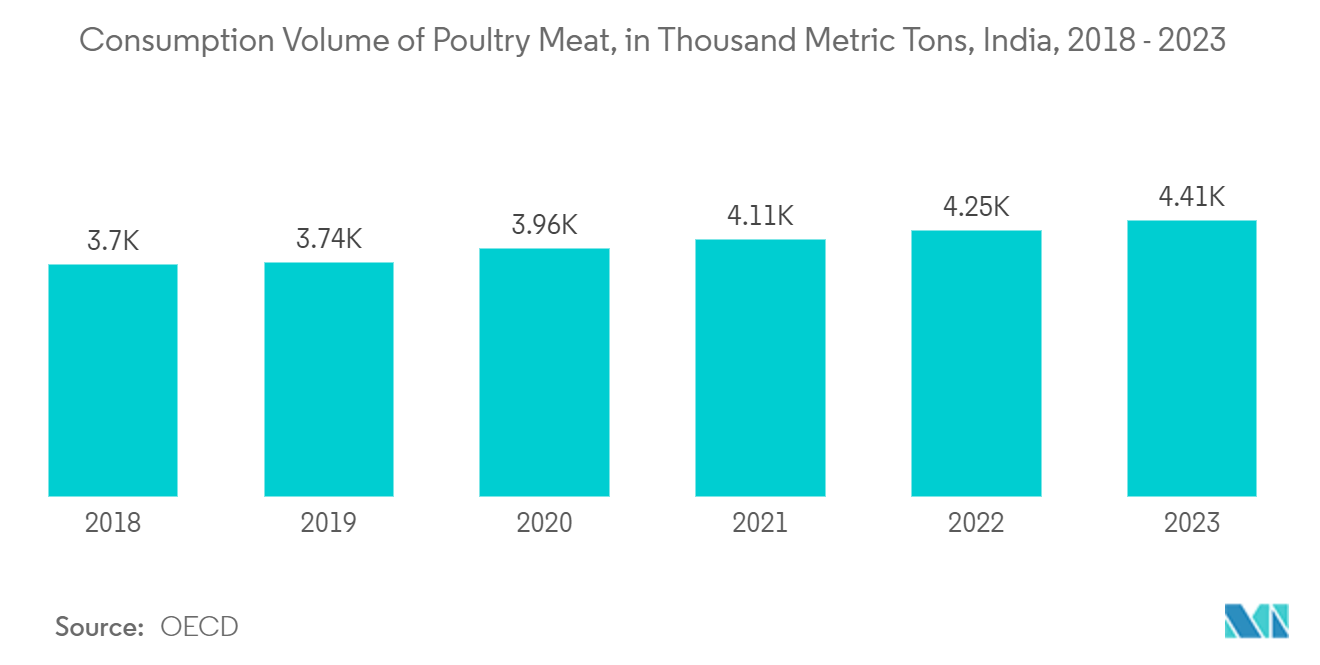Market Trends of Food Packaging Industry
Poultry and Meat Products Expected to Drive Market Growth
- The rise of poultry and meat consumption worldwide is significantly driving demand for innovative food packaging solutions. Packaging plays an essential role in maintaining hygiene throughout the supply chain, from processing plants to consumers. Multi-layered, high-barrier packaging materials prevent contamination by bacteria and other pathogens, reducing the risk of foodborne illnesses. This is especially crucial for meat products as they are highly perishables. For instance, according to the OECD, the consumption of poultry meat in India reached 4,407.2 thousand metric tons in 2023 from 4,253.7 thousand metric tons in 2022.
- As the demand for poultry and meat rises, food packaging manufacturers are introducing new packaging. In May 2024, Tops, a subsidiary of Central Retail, launched eco-friendly meat packaging for its chilled meat sections. It is made from natural plant materials, emphasizes flavor and freshness retention, prioritizes safety, and is eco-conscious. It quickly decomposes, offering a sustainable alternative to traditional plastics.
- Supermarkets are increasingly adopting sustainable packaging for meat products. In May 2023, Tesco Ireland, a subsidiary of British supermarket giant Tesco, started using new packaging called “pillow packs” for its range of fresh mincemeat products. This packaging replaced the traditional plastic tray and film lid, resulting in a significant reduction in plastic usage. Such trends of shifting toward sustainable packaging are creating demand for flexible and rigid packaging for food products.
- The substantial rise in demand for meat products, coupled with a significant shift in meat consumption patterns toward premium-quality and fresh/chilled meat, has emerged as a prominent trend in consumer behavior. The growth in the consumption of meat is increasingly creating demand for various packaging products and is expected to continue over the forecast period.

Asia-Pacific to be the Fastest Growing Market
- The region's food packaging market is experiencing growth, driven by increased exports of fruits and vegetables. As urbanization accelerates in Asia-Pacific countries, the demand for innovative fruit and vegetable powders and pieces is rising. These novel ingredients are easily integrated by food processing companies, enhancing flavors and streamlining the cooking process. Notably, in countries like India, the surge in online food ordering is boosting the demand for packaged food boxes. Statics Indonesia indicates that China and Malaysia are the primary importers of Indonesian fruits. In 2023, Indonesia exported approximately 403.68 million kilograms of fruits to China. Besides China, Indonesia mainly exports fruits to other Southeast Asian countries, such as Malaysia, Thailand, and Vietnam.
- The demand for packaged food is increasing as consumers in Asia become increasingly interested in healthy meals. People desire higher-quality food, whether low-cost, mass-market, or premium, to help them live healthier and more fulfilled lives. Top health items, ranging from dried fruit and nuts to snacks and ready-to-eat packaged meals, are reduced in salt, fat, and sugar and have greater overall nutritional value. For many, this goes hand-in-hand with efforts to combat obesity, heart disease, and other disorders that have accompanied economic progress, increased income, and urbanization.
- Consumers across the region are increasingly seeking better variety, novelty, and higher quality in their food choices. While affluent markets prioritize health and quality, even consumers in lower-income brackets are moving away from price-centric decisions, showing a willingness to experiment with new brands. This shift has significantly enhanced growth prospects for food packaging manufacturers. Both large enterprises and smaller players in the packaging sector are now getting opportunities to tailor solutions to the preferences of today's predominantly urban and convenience-focused end-users. Although environmentally and socially responsible products are progressively gaining traction in several Asian markets, they are well-positioned for sustained success in meeting evolving consumer demands.
- In Singapore, the government is bolstering the food sector to enhance food security by ramping up meat production through non-animal sources. Singapore holds a prominent position in the APAC plant-based meat market. The nation's food manufacturers are intensifying efforts to fortify food security, backed by substantial governmental support. These government-backed initiatives aimed at boosting food production are poised to fuel demand for a range of food packaging solutions.
- In addition, Singapore has a stronger presence of domestic manufacturers dedicated to plant-based meat production, enhancing the nation's global market position. For instance, Next Gen Foods, an innovative startup known for its leading plant-based chicken brand, Tindle, recently secured a significant USD 100 million investment from key industry players. Shandi Global recently launched Singapore's "largest" plant-based chicken manufacturing facility, highlighting advancements in the sector.


